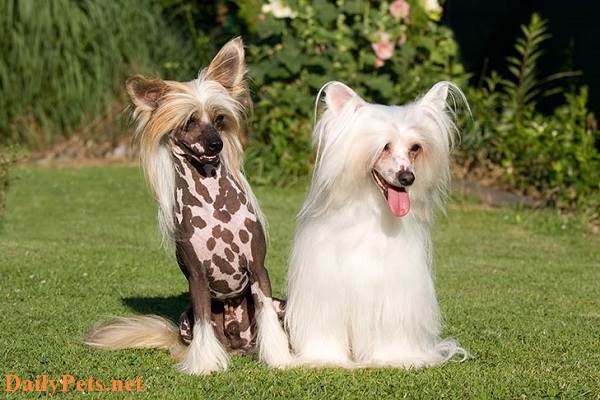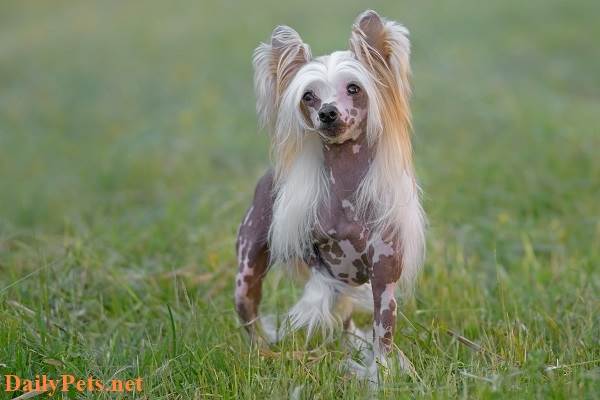The Chinese Crested dog breed is one of the most unique and aesthetically appealing breeds in the world of dogs.
This dog breed has a historical lineage dating back to the 14th century but wasn’t officially recognized by the American Kennel Club (AKC) until 1979. Let’s explore the Chinese Crested dog further in this article from DailyPets.net.
Origin of the Chinese Crested Dog
Despite the name “Chinese Crested,” this breed has no connection to China, and its origins are believed to be from Gela, South America, or even Africa. The association with China likely stems from Chinese sailors in the 13th century who bred these dogs with the aim of making them smaller and more convenient for onboard ship travel and gave them Chinese-inspired names.

Chinese sailors used these dogs for rat-catching; sometimes, they were considered exotic commodities for trade with people in other regions. However, only in the 18th century did the Chinese Crested dog begin to be described in European art and architecture.
It wasn’t until the late 18th and mid-19th centuries that Chinese Crested dogs began to appear in the United States. Gypsy Rose Lee, a famous American dancer, played a pivotal role in getting them recognized and showcased at dog shows. She was also one of the earliest breeders, so many modern Chinese Crested dogs can trace their lineage to her.
Physical Characteristics of the Chinese Crested Dog If a beautiful person walks their dog, it’s highly likely that over 80% of onlookers will turn their heads due to the dog’s “unique” beauty. This innate charm led to their exhibition in the Western world in 1885, winning many World’s Ugliest Dog contests.
The average height of a Chinese Crested dog is around 28 to 33 cm, with a weight ranging from 2 to 6 kg. They have a wide skull, strong bones, a long snout, and straight-standing ears. Their eyes are round and large, resembling human eyes.
The Chinese Crested dog has longer, thinner nails than other breeds, and their feet resemble “rabbit” feet while others resemble “cat” feet.
Classification of the Chinese Crested Dog
The Chinese Crested dog breed includes two types: hairless and powderpuff. They share a common ancestry with a bit of fur on their heads, tails, and legs. They come in various colors, from black to pink and chocolate; some may have spots over their bodies.

Some Chinese Crested dog owners notice changes in their skin color based on the seasons, with their skin becoming darker in warmer weather.
The Hairless variety is exactly as its name suggests – they have no fur except for a tuft of hair on their heads and a small amount of fur on their tails and legs.

The Powderpuff variety is known for its long, soft, and dense fur that covers its entire body. They come from a different gene line, so you can find Hairless and Powderpuff puppies in the same Chinese Crested litter.
Personality Traits of the Chinese Crested Dog
Chinese Crested dogs are playful, sensitive, and enjoy being around their families. They are friendly and have a special affinity for humans. However, caution is advised when they are around young children, as their delicate, hairless bodies make them prone to injury during rough play.
Chinese Crested dogs also tend to get along well with other dog breeds and pets, but due to their rat-catching ancestry, they might not be as friendly towards rodents, including pet hamsters.
They are known for their cheerful and humorous disposition and serve as alert watchdogs for your home. These dogs are easy to train and teach, as they are intelligent and quick learners. They are not typically noisy, making them suitable for urban and apartment living. Chinese Crested dogs are ideal for older individuals who seek a quiet, warm, and joyful companion.
Caring for a Chinese Crested Dog
Chinese Crested dogs do not shed much, but regular grooming is necessary to prevent tangles. It’s recommended to bathe them once every two weeks and trim their nails every two weeks.
Their slim, delicate bodies are prone to sunburn, so it’s crucial to protect them from the sun with sunscreen and, on colder days, provide them with clothing to keep warm.
As these dogs have sensitive skin like humans, it’s best to avoid wool or goat hair materials in their bedding and clothing, as they can cause skin irritation or rashes.
Chinese Crested dogs can gain weight easily, so avoiding overfeeding them is important. Additionally, their teeth may need extra care, as they tend to lose many teeth as they age. Giving them bones is not advisable since they lack enough teeth for chewing.
This dog breed also has well-developed sweat glands, so they don’t rely on panting like most other breeds to cool down. Therefore, they may sweat quite a bit, and you can use moisture-absorbing fabric to prevent sweat from dripping.
In conclusion, Chinese Crested dogs are a unique and endearing breed with distinctive looks and charming personalities. They require special care due to their hairless nature, but their loving nature and adaptability make them wonderful companions for those who appreciate their individuality.
Chinese Crested Dog price
The price of a Chinese Crested dog can vary widely depending on several factors, including the dog’s age, pedigree, quality, breeder reputation, location, and the specific type within the breed (hairless or powderpuff). On average, you can expect to pay anywhere from $1,000 to $3,000 or more for a Chinese Crested puppy from a reputable breeder. Some high-quality, show-quality puppies may even cost more.
Adopting a Chinese Crested dog from a rescue will be less expensive than buying from a breeder. Adoption fees for rescued Chinese Cresteds vary but are generally more affordable, typically ranging from $100 to $500.

















